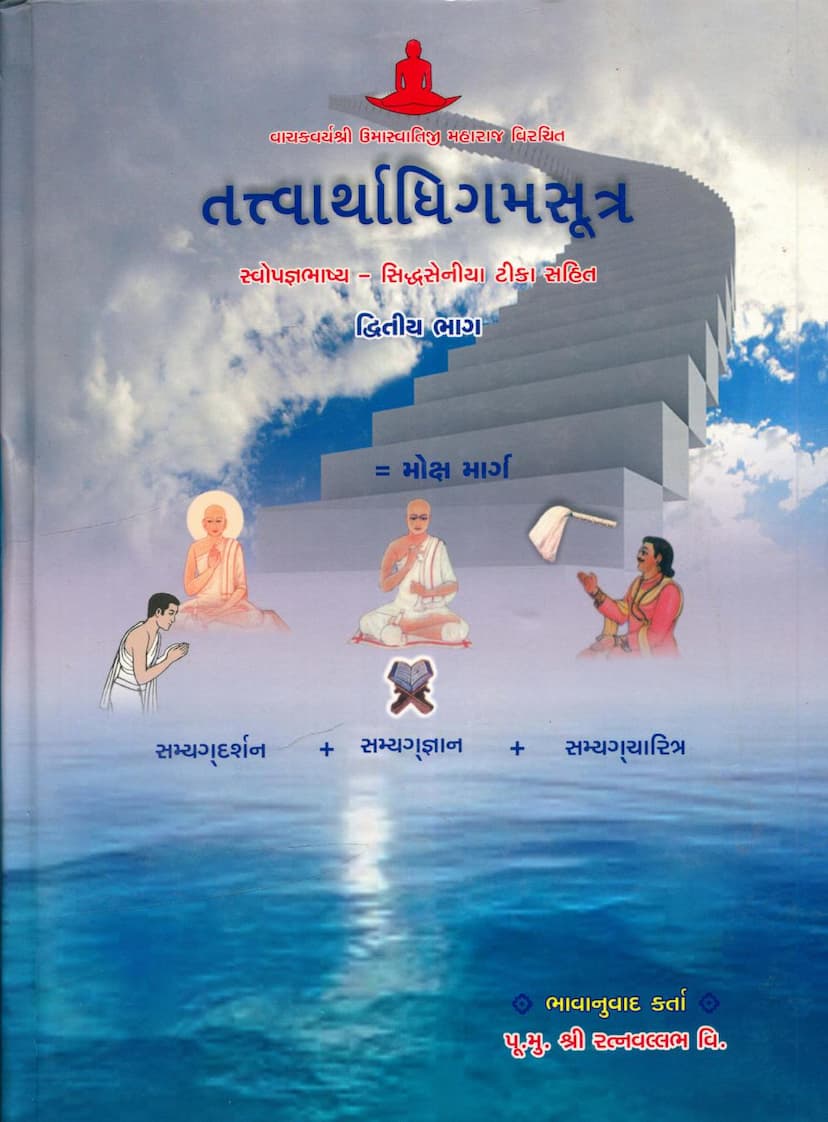Tattvarthadhigam Sutra Part 02
Added to library: September 2, 2025

Summary
Here's a comprehensive summary of the provided Jain text, "Tattvarthadhigam Sutra Part 02" by Ratnavallabhvijay, based on the Gujarati text and its conceptual structure:
Book Title: Tattvarthadhigam Sutra Part 02 Author: Ratnavallabhvijay Publisher: Kamal Prakashan Trust
Overall Scope: This volume, Part 02, of the Tattvarthadhigam Sutra, serves as a commentary (specifically, a Gujarati translation and explanation of the commentary by Siddhsen Gani of the original Bhasya by Umaswati) on the foundational Jain scripture. It delves deeply into the first chapter of the Tattvarthadhigam Sutra, focusing on the exposition of the Moksha Marga (Path to Liberation) which is defined as the triad of Samyak Darshan (Right Faith), Samyak Gyan (Right Knowledge), and Samyak Charitra (Right Conduct). The text meticulously analyzes the initial sutras, explaining their concepts with extensive philosophical and linguistic detail.
Key Concepts and Structure:
The summary highlights the following key aspects covered in the text:
-
The Moksha Marga as the Primary Goal: The introduction emphasizes that true benevolent counsel (hita-upadesha) is only that which guides towards the path of liberation (Moksha). Therefore, the text begins by elucidating the means to achieve Moksha.
-
The Triad of Righteousness (Rishabh Trayi):
- Samyak Darshan (Right Faith): This is explained as a deep-seated inclination or faith towards the truths (tattvas) as revealed by the omniscient beings (Jinas). It's characterized by an understanding that is free from perversion (ayatharth). The text explores its nature, its five signs/characteristics (ling), and its derivation through either natural inclination (nisarga) or acquired learning (adhigam). The importance of the "Samyaq" (Right) adjective is stressed, applying to all three components of the path.
- Samyak Gyan (Right Knowledge): This is elaborated upon by discussing the different types of knowledge: Mati Gyan (Sense-based knowledge), Shrut Gyan (Scriptural knowledge), Avadhi Gyan (Clairvoyant knowledge), Manah-paryay Gyan (Mind-reading knowledge), and Keval Gyan (Omniscience). The text differentiates these, explaining their nature, causes, and scope, particularly highlighting the distinction between ordinary and extraordinary knowledge.
- Samyak Charitra (Right Conduct): While Charitra is mentioned as the third pillar of the path, its detailed exposition appears to be planned for later chapters, as indicated by the commentary's focus on the initial sutras concerning Darshan and Gyan.
-
The Purpose of Causality: The text explains why the scripture begins by discussing the causes (hetu) of Moksha rather than Moksha itself. This is because all effects (karya) are dependent on their causes, and wise individuals prioritize understanding and acquiring the cause first.
-
The Role of "Samyaq" (Right): The commentary emphasizes the importance of the word "Samyaq" (Right) being associated not just with Darshan, but also with Gyan and Charitra, ensuring that all three are correctly understood and practiced. It clarifies that this "rightness" prevents perverted views and actions.
-
The Concept of Nayas (Standpoints): The text dedicates a significant portion to explaining the concept of Nayas, which are different philosophical standpoints or perspectives from which reality can be viewed. The commentary introduces and analyzes several Nayas, including:
- Naigam Naya: Concerned with general or abstract notions, often dealing with the potential or the whole.
- Sangrah Naya: Focuses on unity and generality, grouping things based on shared characteristics.
- Vyavahar Naya: Deals with conventional reality and practical distinctions.
- Rijusutra Naya: Emphasizes the present moment and the momentariness of existence.
- Shabd Naya: Focuses on the literal meaning and form of words, considering the grammar and conventional usage. The text elaborates on their respective interpretations and how they relate to understanding reality.
-
The Seven Tattvas (Realities): The sutras introduce the fundamental Jain realities:
- Jiva: Soul/Living Being
- A jíva: Non-soul/Inanimate Matter
- Asrava: Influx of karmas
- Bandha: Bondage of karmas
- Samvara: Stoppage of karma influx
- Nirjara: Shedding of karmas
- Moksha: Liberation
-
The Role of Nayas: The commentary uses the Nayas to explain how these Tattvas are understood, highlighting that different Nayas can offer valid but partial perspectives on reality. It also discusses how these Nayas are applied to understand concepts like "Dravya" (Substance) and "Paryaya" (Modality).
-
Nirguna Nirakara (Formless, Attributeless) Reality: The text touches upon the concept of the soul's ultimate formless and attributeless nature, especially in the context of Moksha.
-
Types of Knowledge and Their Characteristics: Detailed descriptions are provided for the types of knowledge, including their causes, subjects, and characteristics, particularly differentiating between perception (pratyaksh) and inference (paroksh), and the specific natures of Mati, Shrut, Avadhi, Manah-paryay, and Keval Gyan.
-
The Relationship Between Nayas and Tattvas: The commentary uses the Nayas to explain how the Jiva and other Tattvas are understood, emphasizing that each Naya offers a particular perspective, and understanding all Nayas is crucial for a complete view.
-
Samyak Darshan's Manifestations: The text explains how Samyak Darshan is recognized through the presence of qualities like peace (prasham), enthusiasm for liberation (samveg), detachment from worldly pleasures (nirved), compassion (anukampa), and faith in Jain principles (astikya).
-
The Importance of the First Sutra: The text reiterates the foundational importance of the first sutra, which introduces the Moksha Marga, setting the stage for the detailed exploration of the Tattvas.
Commentarial Approach: The commentary, "Premprabha," appears to be a Gujarati translation and explanation of Siddhsen Gani's commentary on Umaswati's Bhasya. It aims to make the complex philosophical ideas of the Tattvarthadhigam Sutra accessible to the Gujarati-speaking audience, clarifying the meanings of terms, resolving potential doubts, and providing examples.
In essence, the Tattvarthadhigam Sutra Part 02, as summarized, is a profound philosophical and spiritual guide that systematically lays out the Jain path to liberation, meticulously analyzing the core principles of Right Faith, Right Knowledge, and the nature of reality through various philosophical standpoints (Nayas).